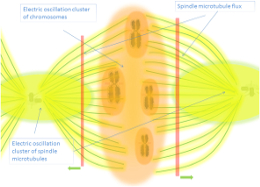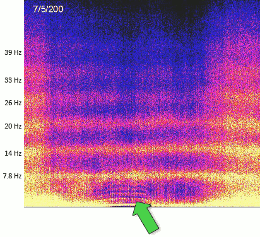

Electromagnetism & Fröhlich Modes
Collective large-scale vibrational modes involving microwave absorption and emission
Fröhlich predicted that biological systems can generate collective vibrational modes in the THz-GHz frequency range, based on the Bose condensation to the lowest excitation of a single mode of the supplied energy. It is proposed that cell membranes, microtubules, DNA and others are sources of this phenomena, this entails, because of their dipolar properties, electromagnetic emissions and absorptions in the THz-GHz range. ...
As described in [1] Fröhlich effect consists in that:
" Provided the energy supply is sufficiently large compared with the energy loss, the system attains a stationary state in which the energy that feeds the polar modes is channeled into the modes with the lowest frequencies. The latter largely increase their populations at the expenses of the other higher-in-frequency modes, in a way reminiscent of a Bose-Einstein condensation."
In biology large molecules and long chain polymers have “extraordinary” dipole properties largely, as Fröhlich theorized, due to the hydrogen bonds, and the interaction of external oscillations can propagate longitudinally resulting in electric modes at certain frequency, those synchronous large-scale collective oscillations imply microwave abortion and emissions.
Because mitochondria generates a strong electric field it is believed that given that mitochondria are aligned in the vicinity of microtubules the latter are immersed in this field, and because both the tubulin heterodimers and microtubules possesses strong electric dipoles that interact with the field it can promote the nonlinear properties represented in the Fröhlich model, so microtubules are a good candidates.
The reality is that Fröhlich modes can also be found in a protein structural network, as proved by Ludholm et al. [2]:
" To that end, we used X-ray crystallography combined with THz radiation to visualize structural changes associated with low-frequency collective vibrations induced in lysozyme protein crystals by irradiation with 0.4 THz radiation and detected steady state structural changes that are sustained for micro- to milli-seconds, which is 3–6 orders of magnitude longer than expected if the structural changes would be due to a redistribution of vibrations upon terahertz absorption following Boltzmann's distribution. Our analyses show that the long lifetime of these structural changes can only be explained by Fröhlich condensation. Our results thus provide the first strong evidence for the occurrence of Fröhlich condensation in a protein structural network and indicate that macroscopic quantum effects may manifest in biological systems."
In another study [3] where is used a model protein of the BSA (Bovine Serum Albumin) they found that this protein also displays a remarkable absorption feature around 0.314 THz. In [4] they also found possible collective vibrational modes in protein after irradiating them with terahertz frequencies:
" In this paper, we observe the protein atoms directly using X-ray crystallography in bovine trypsin at 100 K while irradiating the crystals with 0.5 THz radiation alternating on and off states. We observed that the anisotropy of atomic displacements increased upon terahertz irradiation. Atomic displacement similarities developed between chemically related atoms and between atoms of the catalytic machinery. This pattern likely arises from delocalized polar vibrational modes rather than delocalized elastic deformations or rigid-body displacements."
From another perspective in [5] the authors theoretically study the dynamics of alpha-helical proteins interacting with environment, to see possibility for a Frohlich like mechanism, and found that vibrational mode instability induced by a change in the protein environment interaction parameter can cause a formation of new macroscopic space-temporal structures in the system, a cooperative mode that is caused by the nonlinear interaction of several subsystems in the protein interacting with environment: the regular chains of hydrogen bonds, side chain radicals, and hydrogen bond network of water molecules. All this can help to explain the extraordinary effectiveness of protein biological functions such as energy storage, transport and transformation.
In [6] nucleobases and nucelosides of DNA, in this case, have been found as a possible candidate for this phenomena:
" ... Nucleobases and nucelosides are a key component of DNA and RNA, and have shown interesting characteristic features in the region of 20 to 600 cm-1 (0.6 to 20 THz). This work has provided evidence that there are unique absorption features across the frequency range which have not been seen before due to the limited frequency ranges and relatively low signal to noise inherent to other THz techniques."
There are various proposals to integrate those non-linear phenomena with other non-linear electromagnetic emission, like those in the optic range (including near-infrared and ultraviolet) termed biophotons or ultraweak photon emissions (UPE) as can be seen in [7][8]. Swain [8] wrote:
" ... the factor of 400 or so derived above is about what one would want to get from Fröhlich frequencies in the microwave region to visible Popp photons ... There is even a degree of reversibility in the system and one can imagine coupling what we have so-far considered as an outgoing photon mode to an external visible photon which could in turn be down-converted into Fröhlich photons. This offers the possibility of affecting Fröhlich dynamics inside a cell via visible photons injected from outside, as well as to the possibility of a long range coupling of internal cellular Fröhlich dynamics between cells via visible Popp photons. This also suggests new experiments looking for microwave responses to visible stimulation and vice-versa."
There is a wide section dedicated to biophotons in this website [9], here we will continue describing some other interesting experimental findings and postulates in respect to Fröhlich condensates.
Preto et al. [10] propose that given the fact that experimental evidence for the existence of collective excitations within macromolecules of biological relevance is available for proteins and forpolynucleotides (DNA and RNA), with coherent collective oscillation modes of the whole molecule (protein or DNA) or of a substantial fraction of its atoms, a mechanism such as Fröhlich condensation (or more generally dynamic synchronizations) between molecules turns out to be effectively active in biological systems, implying long-range attractive interactions between biomolecules provided that the latter share common frequencies in their vibration spectra.
Taking in consideration the above mentioned mitochondrial-microtubular EM relation, Šrobár [11] proposed that it's disruption causes cancer.
" The computed results show that simultaneous presence of both sufficient metabolic pumping and adequately elevated static electric field is necessary for the full unfolding of the hallmark properties of the Fröhlich model. It is suggested that cancer-related mitochondrial dysfunction leading to metabolic transformation has additional adverse effect mediated by diminution of static fields which in turn reduces the nonlinear processes in the Fröhlich systems, essential for energy condensation in the fundamental mode."
E. Anton et al. [12] wrote:
" ... due to the interactions between bose condensed quasi-particles, it seems that periodical transformations of the phonons into photons and vice versa take place. If this interaction is strong, both photons and phonons can no longer be considered independent. In this way, these two excited states coupled constitute a mixture of phononi and photons called polaritons [15]. When the milimeter photons and phonons are in the bose-condensed state, the formed polaritons will be in the same state."
And proposes that the Fröhlich condensate is the medium by which millimeter wave therapies can act on biosystems.
References:
Very related sections:
↑ text updated: 29/06/2020
↓ tables updated: 29/06/2020
Endogenous Fields & Mind
 EM & Fröhlich Modes
EM & Fröhlich Modes
.
.























